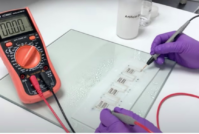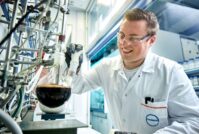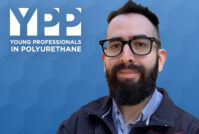look what we did!
Category: 2014 Polyurethane Technical ConferenceCPI Announces Finalists for 2014 Polyurethane Innovation Award
BASF, Dow and Novomer Named Finalists
The Center for the Polyurethanes Industry (CPI) of the American Chemistry Council (ACC) today announced BASF, Dow and Novomer as the finalists for the 2014 Polyurethane Innovation Award. Attendees at the 2014 Polyurethanes Technical Conference, will have the opportunity to vote for one of these finalists during the conference’s opening session on Monday, Sept. 22. The winner will be announced during the closing session on Wednesday, Sept. 24.
The conference will take place at the Gaylord Texan Resort and Convention Center in Dallas.
“We received such exciting submissions for this year’s 2014 Polyurethane Innovation Award, and I am very proud to recognize these three outstanding finalists,” said CPI Senior Director Lee Salamone. “I congratulate all three companies on their work to advance technology and the polyurethane industry. It was a very difficult choice for the judges due to outstanding entries from many companies.”
The innovations selected as finalists for this year’s coveted award are:
BASF: InfinergyTM
With InfinergyTM, BASF introduces the world’s first particle foam based on expanded, thermoplastic polyurethanes. The combination of important mechanical properties and easy processing with an available technology make the material unique. InfinergyTM offers unprecedented unknown high energy return with excellent tensile and flexural characteristics. As a result, InfinergyTM is used as main sole component of adidas’ new running shoe series “Boost,” brought to market shortly after its development at BASF. Numerous additional applications are planned in the leisure, sports or packaging sector.
Dow: TERAFORCETM Technology
This collaborative innovation between The Dow Chemical Company and Preferred Sands expands the frontiers of polyurethane applications by improving oil productivity and the sustainability profile of the hydraulic fracturing process, which is an important element of the U.S. energy boom, manufacturing renaissance and job creation. Preferred RCSTM Resin Coated Sand with Dow TERAFORCETM Technology (the enabling polyurethane) saves energy during production of the resin-coated proppant through shorter production cycles and low temperature, and reduces hazardous risks associated with proppant flowback. The technology also eliminates the need for an external activator, or additional chemicals, that competing technologies require to be injected into oil wells. The two companies continue to develop technologies for broader applications across energy markets, and ever-more efficient and sustainable oil and gas recovery.
• RCSTM is a trademark of Preferred Sands
• TERAFORCETM is a trademark of The Dow Chemical Company or an affiliated company
Novomer: Converge®
Novomer Inc. has pioneered technology that allows waste carbon dioxide to be combined with traditional chemical feedstocks to produce polypropylene carbonate polyols for use in polyurethane formulations. These polyols contain more than 40% carbon dioxide and are targeted for use in coatings, adhesives, sealants, and elastomers, as well as rigid and flexible foams. They are being marketed under the Converge® trade name, representing the convergence of performance, cost-effectiveness, and sustainability. In addition to reducing the petrochemical feedstocks by up to 50%, Converge Polyols are unique in their alternating CO2 – epoxide units in the carbonate backbone. This structure yields high performance properties such as durability, chemical and UV resistance, and strength. Converge® Polyols also have a significantly reduced carbon and energy footprint compared to traditional polyols
Award Selection
A panel of judges, comprised of experts representing technical disciplines and the polyurethane supply chain, evaluated all eligible submissions. Judges evaluated and scored all entries based on impact on the polyurethanes industry, uniqueness of the innovation, quality of the science and societal impact. The three submissions with the highest scores were selected as finalists for the 2014 Polyurethane Innovation Award. Each finalist will prepare a poster describing the innovation which will be on display at the conference.
Each finalist will also share a three-minute presentation detailing the uniqueness and impact of the innovation, along with the benefits it will bring to the industry and society, during the opening session of the 2014 Polyurethanes Technical Conference on Monday, Sept. 22. Each individual conference registrant attending the opening session may cast one vote for one finalist. The finalist with the most votes from the audience will receive an additional 20 points to be added to the score from the judges. The innovation with the highest total score will be deemed the winner and announced on Wednesday, Sept. 24, during the closing session of the 2014 Polyurethanes Technical Conference.
Eligibility
All entries for the 2014 award were required to represent new innovations that have not been previously submitted for the Innovation Award and had not been available for commercial sales longer than 15 months prior to June 18, 2014.
Entries pertaining to a polyurethane product or polyurethane manufacture were required to relate to polyurethane chemistry, which is expressly defined as the reaction of an isocyanate with a polyol. Innovations in polyurethane chemistry may include finished products, initiatives, training or education programs, or processes or processing equipment.
# # #
http://www.americanchemistry.com
The American Chemistry Council (ACC) represents the leading companies engaged in the business of chemistry. ACC members apply the science of chemistry to make innovative products and services that make people’s lives better, healthier and safer. ACC is committed to improved environmental, health and safety performance through Responsible Care®, common sense advocacy designed to address major public policy issues, and health and environmental research and product testing. The business of chemistry is an $812 billion enterprise and a key element of the nation’s economy. It is the nation’s largest exporter, accounting for twelve percent of all U.S. exports. Chemistry companies are among the largest investors in research and development. Safety and security have always been primary concerns of ACC members, and they have intensified their efforts, working closely with government agencies to improve security and to defend against any threat to the nation’s critical infrastructure.

























